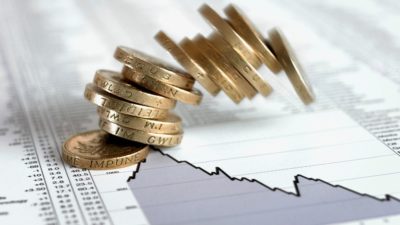To me, capital growth and dividend income are equally important. Together, they provide the total return from any share investment and, as you might expect, my aim is to invest in companies that can beat the total return delivered by the wider market.
To put that aim into perspective, the FTSE 100 has provided investors with a total return of around 3% per annum since January 2008.
Quality and value
If my investments are to outperform, I need to back companies that score well on several quality indicators and buy at prices that offer decent value.
So this series aims to identify appealing FTSE 100 investment opportunities and today I’m looking at Royal Bank of Scotland Group (LSE: RBS) (NYSE: RBS.US), the troubled Edinburgh-headquartered banking organisation.
With the shares at 326p, Royal Bank of Scotland’s market cap is £20,080m.
This table summarises the firm’s recent financial record (per-share figures adjusted for 2012’s share consolidation.):
| Year to December | 2008 | 2009 | 2010 | 2011 | 2012 |
|---|---|---|---|---|---|
| Revenue (£m) | 25,868 | 33,026 | 31,798 | 24,651 | 17,941 |
| Net cash from operations (£m) | (75,338) | (992) | 19,291 | 3,325 | (45,113) |
| Diluted earnings per share | (1462p) | (63p) | (5p) | (21.3p) | (53.7p) |
| Dividend per share | 193p | 0 | 0 | 0 | 0 |
The recent interim results statement enabled Royal Bank of Scotland’s directors to declare that, “RBS Group has earned its first two consecutive quarters of overall profit since 2008.” That’s a long time to spend in the dark, but a half-time profit after tax from continuing operations of £696m, or 3.8p per share, provides one of the first real post-financial-crisis chinks of light that investors have yet seen.
The five-year financial record is a seething quagmire of big cash outflows, consistent losses and shrinking revenues. When the music stopped with the credit crunch, Royal Bank of Scotland’s huge leveraged balance sheet emerged as residing more at the liability end of the asset/liability continuum. The result was some hastily arranged capital raising events during 2008 that heavily diluted existing shareholders and left most of the new shares in the hands of Her Majesty’s Treasury.
Since then, a focus on simplification and efficiency has seen the firm restructure to ditch many of its pre-crisis big-earning but capital-intensive lines of business that rely so much on money-market funding. By focusing on capital strength, the directors aimed to build a secure platform for growth along more traditional banking lines.
A return to profit now signals some progress with the plan. But although RBS is currently trading well below its net asset value, I reckon it needs to prove itself with consistent earnings and positive cash flow before the share price is likely to lift. I’m neutral on the firm’s total-return prospects from here.
Royal Bank of Scotland’s total-return potential
Let’s examine five indicators to help judge the quality of the company’s total-return potential:
1. Dividend cover: recent positive earnings suggest potential for future dividend cover. 1/5
2. Borrowings: at around £37 billion, wholesale funding is much larger than earnings.1/5
3. Growth: recent positive earnings and reducing cash outflow. 3/5
4. Price to earnings: a forward 10 looks fair given the uncertainties. 3/5
5. Outlook: satisfactory recent trading and a cautiously optimistic outlook. 3/5
Overall, I score Royal Bank of Scotland 11 out of 25, which inclines me to caution with regard to the firm’s potential to outpace the wider market’s total return, going forward.
Foolish summary
RBS still has a lot to prove, but recent progress on cash flow and profitability is encouraging. I already own some shares, which I’ll now hold to see what happens.
If I were buying for the first time, Royal Bank of Scotland would probably stay on my watch list in favour of more consistent earners that pay rising dividends, too. But companies with seemingly impregnable, moat-like financial characteristics can be hard to come by, which is why I’m enthusiastic about a new Motley Fool report, prepared by our top analysts, that highlights five such shares.
“5 Shares To Retire On”, presents five shares that deserve consideration by investors aiming to build wealth in the long run. For a limited period, the report is free. I recommend downloading your copy now by clicking here.
> Kevin owns shares in Royal Bank of Scotland.







